How to Facilitate Constructive Debate and Dialogue in Meetings

Introduction
In today's fast-paced and dynamic business landscape, fostering constructive debate and dialogue in meetings is more critical than ever. A vibrant exchange of ideas can lead to enhanced decision-making and foster a culture of innovation. By embracing diverse opinions and perspectives, organizations can stay ahead of the curve, adapting to change and solving complex problems with creativity and finesse. In this article, we'll explore the art of facilitating constructive debate and dialogue in meetings, and provide practical tips for ensuring that everyone's voice is heard.
The foundation of constructive debate lies in understanding its importance and the impact it has on driving effective decision-making and innovation. It's essential to create an environment that encourages open communication, challenges assumptions, and builds trust among team members. By understanding the significance of constructive debate and dialogue, you'll be well-equipped to create a more inclusive and effective meeting culture.
The Role of Constructive Debate and Dialogue in Meetings
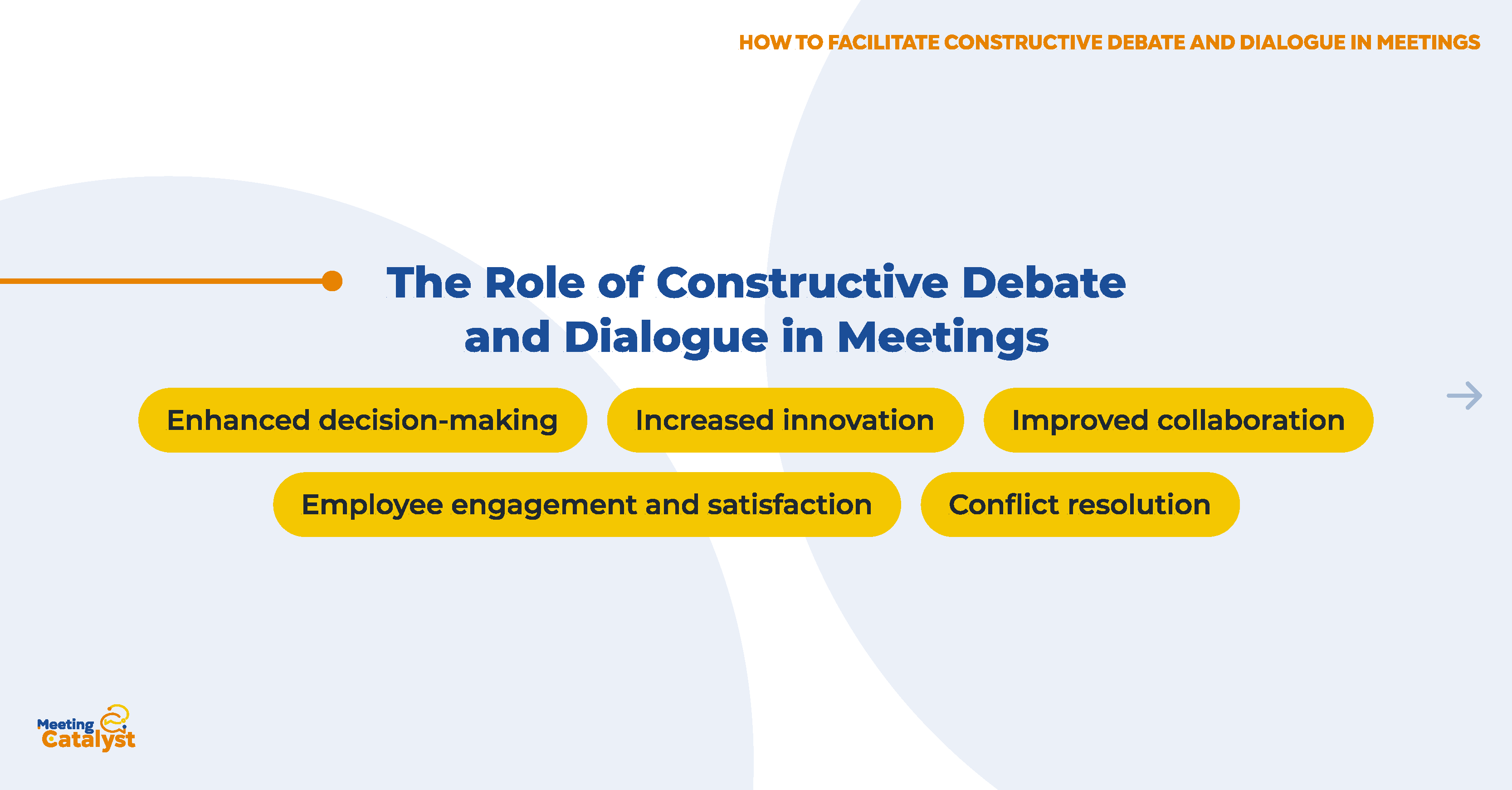
Constructive debate and dialogue play a vital role in enabling organizations to unlock their full potential by fostering a culture of collaboration, innovation, and continuous improvement. The benefits of engaging in meaningful conversations and exchanging diverse perspectives during meetings are manifold. Let's delve into the key roles that constructive debate and dialogue serve in meetings:
Enhanced decision-making: When diverse opinions and ideas are openly shared and discussed, the collective intelligence of the group is harnessed. This results in more informed decision-making, as the various perspectives brought to the table can help identify risks, opportunities, and potential pitfalls that may otherwise be overlooked.
Increased innovation: Engaging in constructive debate and dialogue fosters a culture of innovation. By challenging assumptions and encouraging out-of-the-box thinking, organizations can identify novel solutions and approaches to solve complex problems and drive continuous improvement.
Improved collaboration: Constructive debate and dialogue can help break down silos within teams and organizations. By encouraging open communication and active listening, team members can build trust, enhance empathy, and develop a deeper understanding of one another's perspectives.
Employee engagement and satisfaction: Employees who feel heard and valued are more likely to be engaged and committed to their work. Constructive debate and dialogue in meetings can help ensure that everyone's voice is heard, fostering a sense of ownership and pride in the team's collective accomplishments.
Conflict resolution: Conflicts are inevitable in any organization. However, when managed effectively through constructive debate and dialogue, conflicts can be transformed into opportunities for growth and learning. This approach helps teams to address underlying issues, find common ground, and reach consensus more effectively.
By embracing the role of constructive debate and dialogue in meetings, organizations can harness the power of diverse perspectives to drive better outcomes and create a more inclusive, innovative, and effective working environment.
The Difference Between Constructive Debate and Unproductive Conflict
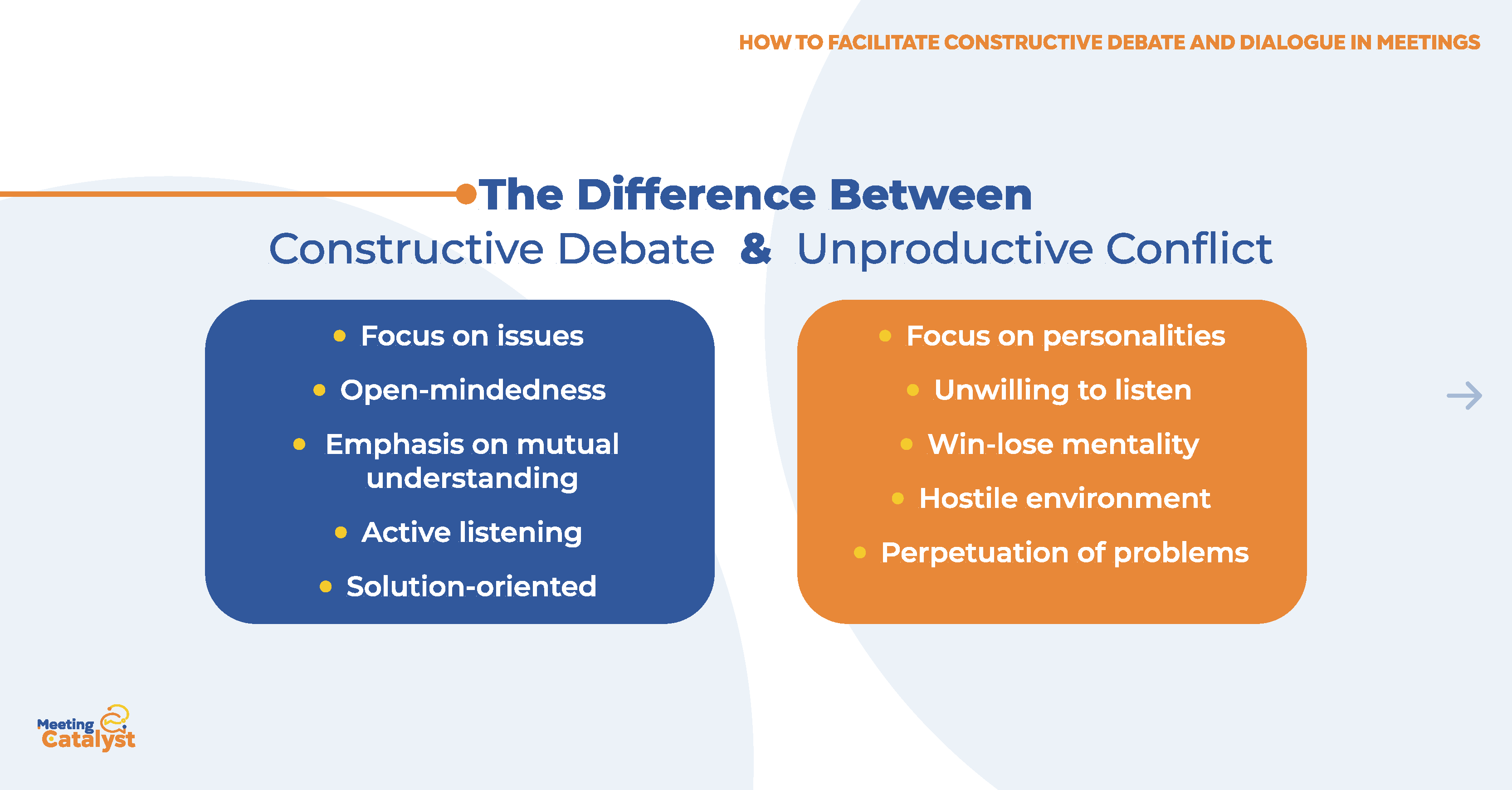
While both constructive debate and unproductive conflict involve disagreements and differences of opinion, they differ significantly in their impact on team dynamics, productivity, and overall organizational health. Understanding these distinctions is crucial for fostering healthy debates that drive growth and improvement, rather than allowing conflicts to escalate and undermine team performance. Here are the key differences between constructive debate and unproductive conflict:
Focus on issues, not personalities: Constructive debate centers on discussing ideas, opinions, and issues, rather than attacking individuals or their personalities. In contrast, unproductive conflict often involves personal attacks, name-calling, and blaming, which can damage relationships and erode trust among team members.
Open-mindedness: During constructive debate, participants remain open to the possibility of changing their opinions and learning from others. In unproductive conflict, individuals tend to be entrenched in their positions and unwilling to listen to or consider alternative perspectives.
Emphasis on mutual understanding: In a constructive debate, the primary goal is to achieve a deeper understanding of the issue at hand and explore diverse perspectives. Unproductive conflict, on the other hand, is often characterized by a win-lose mentality, where participants focus on proving their point and discrediting others.
Active listening: Constructive debate involves active listening, empathy, and genuine curiosity about others' perspectives. Participants in unproductive conflict frequently interrupt, dismiss, or belittle others' ideas, creating a hostile environment that stifles open communication.
Solution-oriented: Constructive debate aims to find solutions, reach consensus, and resolve differences constructively. In contrast, unproductive conflict tends to perpetuate problems and impede progress, as participants become more focused on defending their positions than on finding common ground.
By recognizing the difference between constructive debate and unproductive conflict, leaders and team members can actively work to promote healthy, productive discussions that drive innovation, collaboration, and continuous improvement in their organizations.
Establishing Ground Rules for Constructive Debate
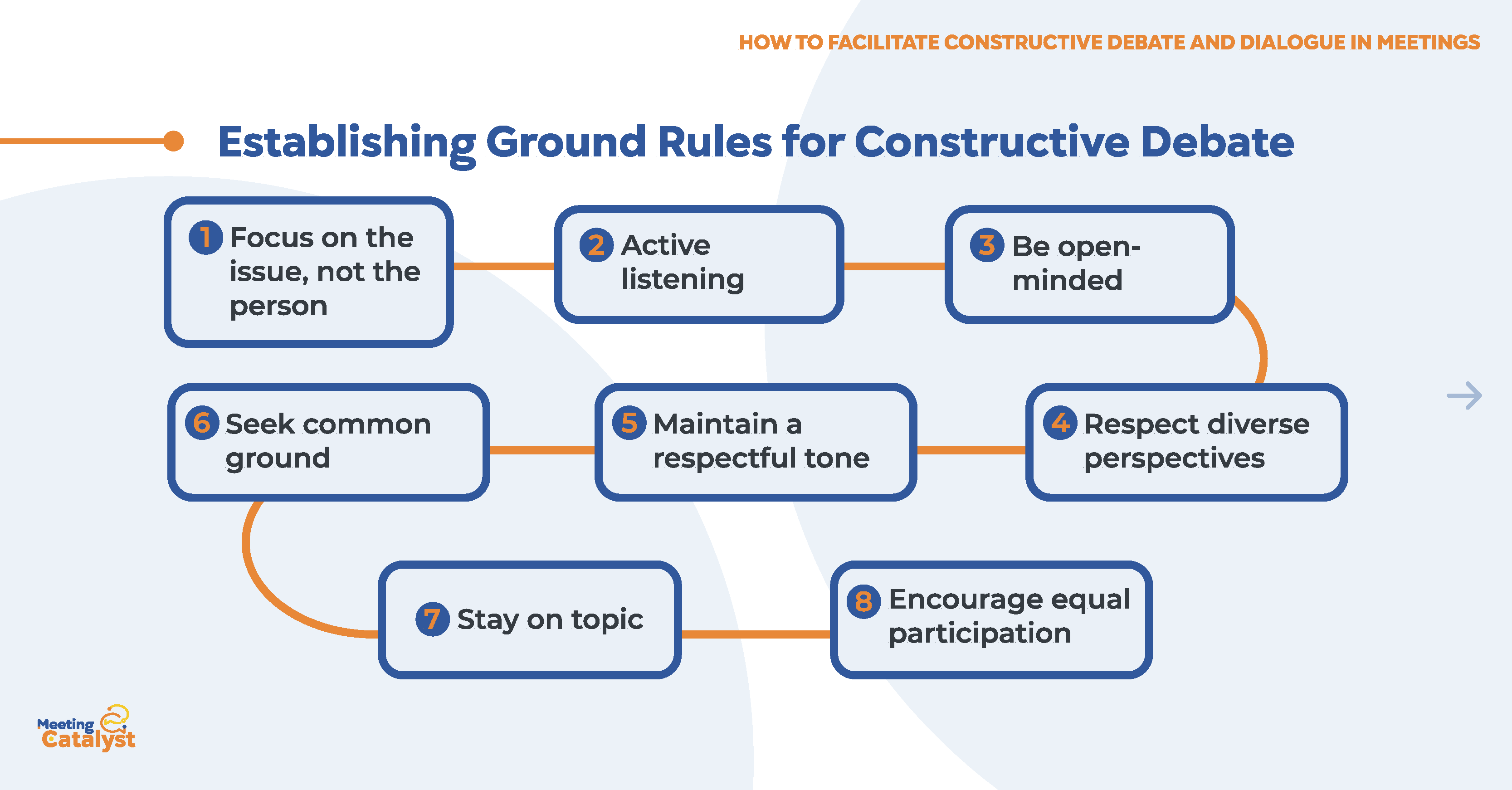
To facilitate constructive debate and dialogue in meetings, it's crucial to establish a set of ground rules that encourage open communication, mutual respect, and effective problem-solving. These guidelines will help create a safe environment where team members feel comfortable sharing their ideas and opinions without fear of personal attacks or ridicule. Here are some essential ground rules for fostering constructive debate:
Focus on the issue, not the person: Encourage participants to discuss ideas and opinions, rather than making personal attacks or judgments. This approach promotes a healthy exchange of perspectives and fosters mutual understanding.
Active listening: Emphasize the importance of active listening, which includes giving others your full attention, refraining from interrupting, and asking clarifying questions to ensure comprehension.
Be open-minded: Encourage team members to remain open to new ideas and be willing to change their opinions based on the information and insights shared during the debate.
Respect diverse perspectives: Acknowledge and respect the diversity of opinions and experiences within the team. Recognize that different perspectives can contribute to a richer understanding of the issue at hand and lead to more innovative solutions.
Maintain a respectful tone: Remind participants to communicate their thoughts and ideas with courtesy and respect, avoiding aggressive or condescending language.
Seek common ground: Encourage participants to identify areas of agreement and work collaboratively towards finding mutually beneficial solutions.
Stay on topic: Ensure that the conversation remains focused on the issue at hand, avoiding distractions and unrelated tangents.
Encourage equal participation: Strive for balanced participation, giving all team members an opportunity to contribute their ideas and perspectives.
By establishing and consistently enforcing these ground rules, organizations can create an environment where constructive debate thrives, leading to more effective decision-making, improved collaboration, and increased innovation.
Techniques for Facilitating Constructive Debate
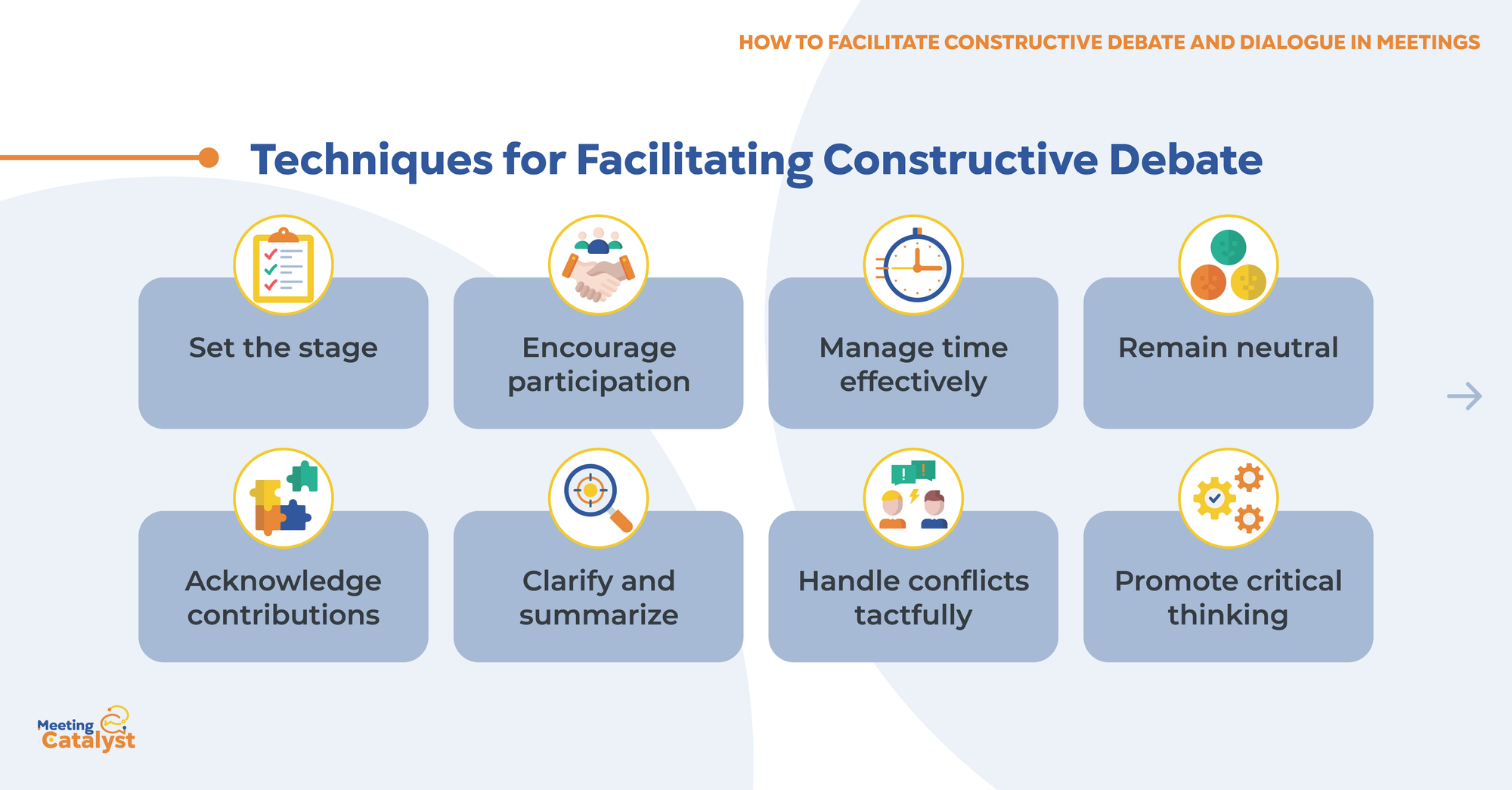
Effective facilitation is key to promoting constructive debate and dialogue in meetings. As a facilitator, your role is to create an environment where participants feel comfortable sharing their ideas, asking questions, and engaging in meaningful discussions. Here are some essential techniques to help you successfully facilitate constructive debate:
Set the stage: Clearly articulate the purpose of the meeting and the importance of engaging in constructive debate. Provide an overview of the topic and establish the ground rules to ensure a respectful and productive discussion.
Encourage participation: Create opportunities for all team members to share their ideas and opinions. Use open-ended questions to stimulate discussion and invite input from quieter participants.
Manage time effectively: Allocate adequate time for each discussion point, ensuring that the debate remains focused and on track. Be mindful of time constraints and prioritize topics according to their importance and relevance.
Remain neutral: As the facilitator, maintain neutrality and avoid expressing personal opinions. Your role is to guide the discussion, not to dominate or influence the outcome.
Acknowledge contributions: Recognize and appreciate the contributions made by participants. Show gratitude for their insights and encourage others to build on their ideas.
Clarify and summarize: Regularly summarize key points and ask for clarification when needed. This helps maintain focus and ensures that all participants are on the same page.
Handle conflicts tactfully: Address conflicts or disagreements respectfully, emphasizing the importance of focusing on the issue, not the person. Encourage participants to find common ground and seek solutions that benefit everyone involved.
Promote critical thinking: Challenge participants to think deeply about the topic and consider alternative perspectives. Encourage the evaluation of evidence, the identification of assumptions, and the exploration of consequences.
By implementing these techniques, facilitators can create an environment that supports constructive debate, fosters collaboration, and ultimately leads to better decision-making and problem-solving within the organization.
Managing Emotions and Conflict During Debate
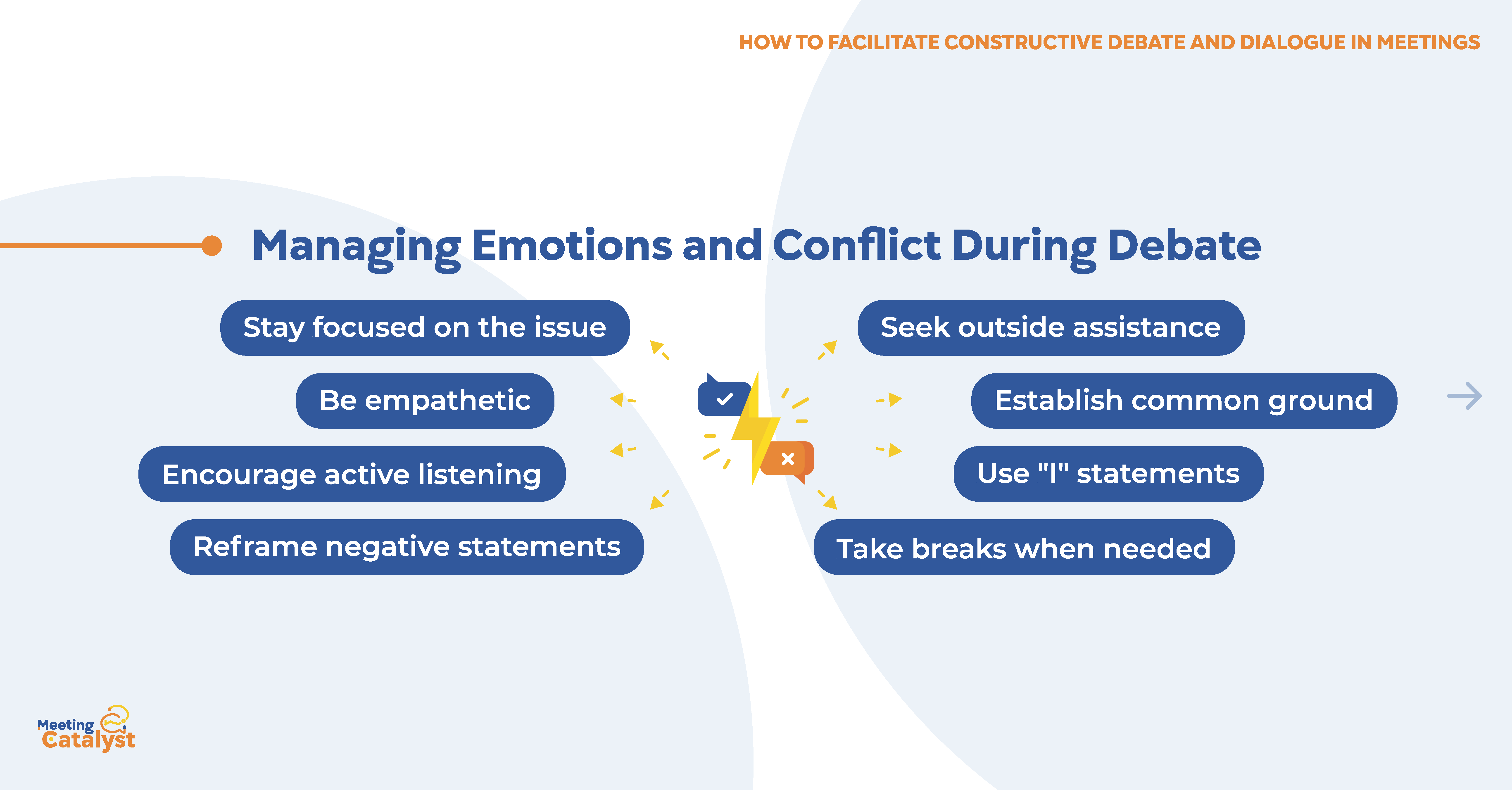
Emotions and conflicts are inevitable during constructive debates. However, managing them effectively is crucial to maintaining a productive and respectful environment. Here are some strategies to help you manage emotions and conflict during debates:
Stay focused on the issue: Encourage participants to focus on the topic at hand and avoid personal attacks. Emphasize the importance of discussing ideas, not individuals, to keep the conversation respectful and constructive.
Be empathetic: Show understanding and empathy for the emotions and perspectives of others. Acknowledge their feelings and demonstrate that you are genuinely interested in their point of view.
Encourage active listening: Promote active listening by asking participants to restate or paraphrase the opinions of others before responding. This helps to ensure that everyone's ideas are heard and understood.
Reframe negative statements: When conflicts arise, try to reframe negative statements into more constructive ones. For example, change "That idea will never work" to "What are the potential challenges we might face with this idea?"
Take breaks when needed: If emotions run high or conflict becomes unproductive, consider taking a short break to allow participants to cool down and regain composure.
Use "I" statements: Encourage the use of "I" statements rather than "you" statements to express feelings and opinions. This helps to reduce defensiveness and promotes a more open and constructive dialogue.
Establish common ground: Identify areas of agreement among participants and build on them. Finding common ground can help to diffuse tension and facilitate collaboration.
Seek outside assistance: If conflicts become particularly challenging or persistent, consider seeking assistance from a professional mediator or conflict resolution expert.
By employing these strategies, facilitators can effectively manage emotions and conflicts during debates, ensuring that discussions remain respectful, constructive, and focused on achieving the best possible outcomes for the team and organization.
Encouraging Participation from All Team Members
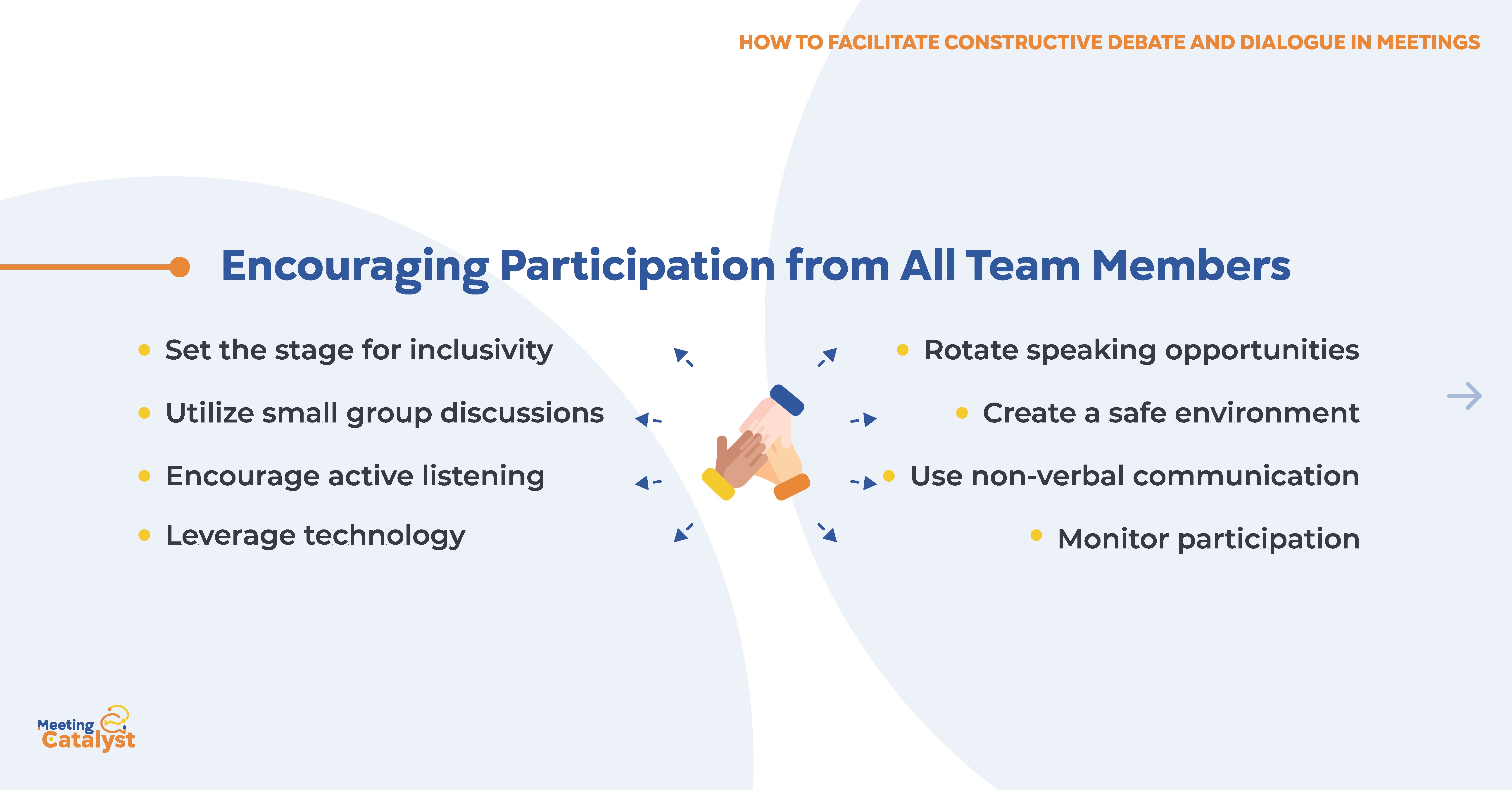
Inclusive and diverse debates contribute to more comprehensive and well-rounded decisions. Ensuring that all team members have an equal opportunity to participate in discussions is crucial for productive meetings. Here are some strategies for encouraging participation from everyone:
Set the stage for inclusivity: Begin the meeting by emphasizing the importance of hearing from all perspectives and inviting everyone to share their thoughts. Remind participants that their input is valuable and crucial to the decision-making process.
Rotate speaking opportunities: Assign a moderator to help facilitate the discussion, ensuring that all team members have an opportunity to speak. Encourage participants to take turns sharing their thoughts and opinions.
Utilize small group discussions: Break the meeting into smaller groups, allowing quieter team members to contribute in a more comfortable setting. Afterward, have each group present their ideas to the larger group.
Create a safe environment: Foster an atmosphere of psychological safety, where team members feel comfortable expressing their opinions without fear of judgment or retribution.
Use non-verbal communication: Encourage the use of non-verbal communication, such as hand gestures or visual aids, to help participants express their ideas and opinions more effectively.
Encourage active listening: Promote active listening and ask participants to restate or paraphrase the opinions of others before responding. This helps to ensure that everyone's ideas are heard and acknowledged.
Leverage technology: Use technology like virtual whiteboards, real-time polling, or chat features to help engage participants and gather their input during remote or hybrid meetings.
Monitor participation: Keep track of who is contributing to the discussion and gently encourage those who haven't yet shared their thoughts to do so. Be mindful of any biases that may influence whose voices are being heard.
By implementing these strategies, facilitators can encourage full participation from all team members, ensuring that diverse perspectives are considered and resulting in more informed, well-rounded decision-making.
The Role of the Meeting Facilitator in Constructive Debate
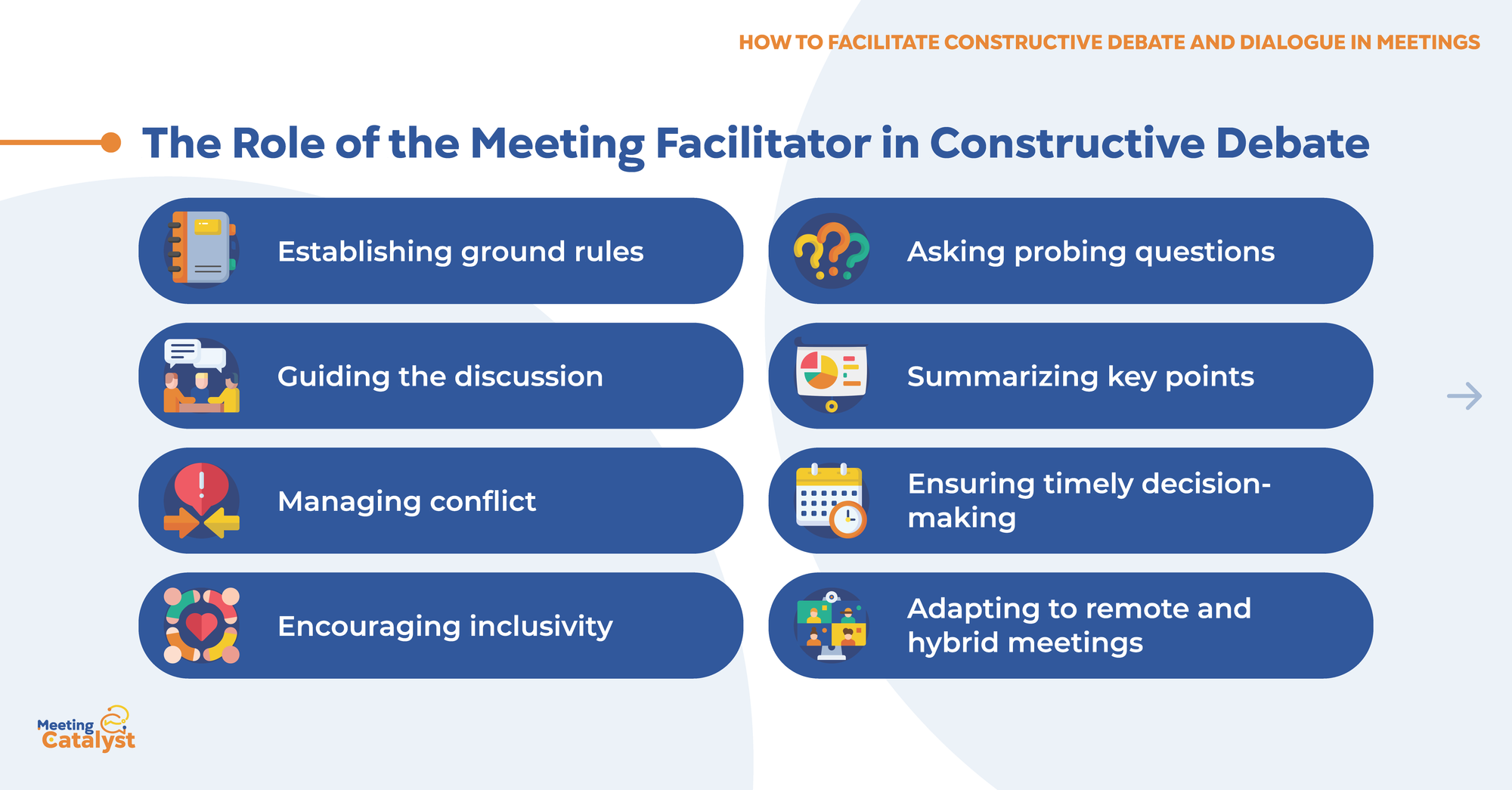
The meeting facilitator plays a pivotal role in fostering constructive debate and dialogue during meetings. By effectively managing the discussion, the facilitator can ensure that all voices are heard and that the debate remains focused and productive. Here are some key responsibilities of the meeting facilitator:
Establishing ground rules: The facilitator sets the tone for the meeting by establishing and enforcing ground rules, such as respectful communication, active listening, and equal participation.
Guiding the discussion: The facilitator helps keep the conversation on track, redirecting the discussion when necessary and ensuring that all participants have an opportunity to contribute.
Managing conflict: The facilitator must be able to address and defuse conflicts that arise during the debate, promoting a respectful exchange of ideas and fostering an environment where constructive disagreement can thrive.
Encouraging inclusivity: The facilitator should strive to create a safe and inclusive atmosphere, encouraging input from all participants, particularly those who may be hesitant to speak up.
Asking probing questions: The facilitator can use powerful questions to promote deeper exploration of ideas, challenge assumptions, and help participants uncover new perspectives.
Summarizing key points: The facilitator should periodically summarize the key points of the discussion, ensuring that everyone is on the same page and that important ideas are not overlooked.
Ensuring timely decision-making: The facilitator must manage the meeting's time effectively, helping participants reach decisions within the allotted timeframe and preventing the discussion from becoming overly drawn-out or unproductive.
Adapting to remote and hybrid meetings: In remote or hybrid settings, the facilitator must leverage technology to engage participants, ensuring that everyone can contribute and that the conversation remains focused and collaborative.
By skillfully performing these tasks, the meeting facilitator can create an environment where constructive debate and dialogue can flourish, leading to more effective decision-making and enhanced team collaboration.
Adapting Debate and Dialogue Techniques to Remote and Hybrid Meetings
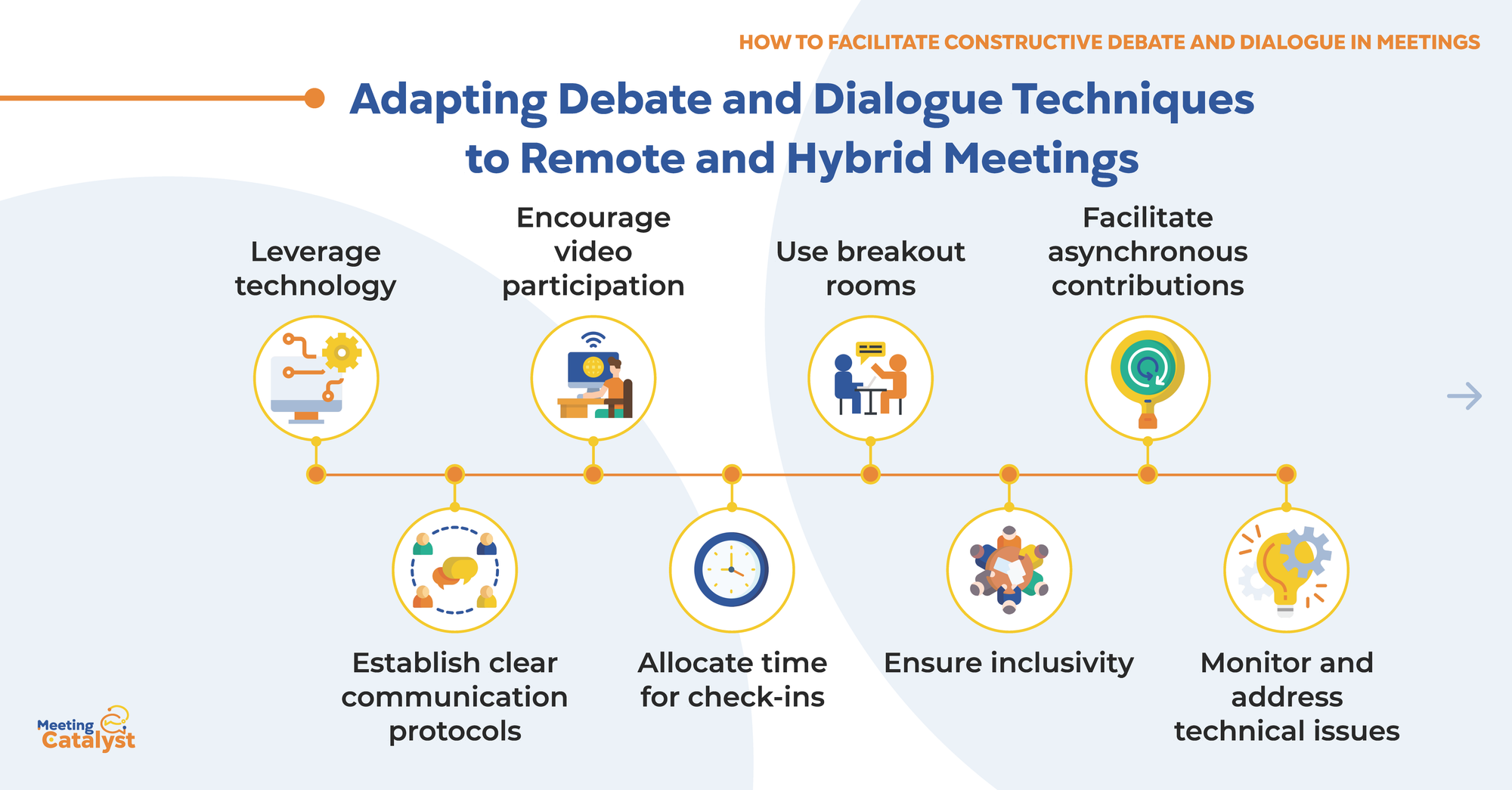
As remote and hybrid meetings become increasingly common in today's workplace, it's crucial to adapt debate and dialogue techniques to ensure that these discussions remain productive and inclusive. Here are some key strategies for facilitating constructive debate in remote and hybrid settings:
Leverage technology: Utilize video conferencing platforms, chat tools, and virtual whiteboards to facilitate communication and collaboration among participants. Ensure that everyone is comfortable with the technology and has access to the necessary resources.
Establish clear communication protocols: Clearly communicate expectations for participation, such as muting microphones when not speaking, using the "raise hand" feature to request a turn, and engaging in text-based chat for side discussions or questions.
Encourage video participation: Encourage participants to turn on their cameras during the meeting, as this can help to create a more personal connection and foster a sense of presence among remote team members.
Allocate time for check-ins: Begin the meeting with a brief check-in to gauge the mood and energy levels of participants, particularly in remote settings where nonverbal cues may be more difficult to discern.
Use breakout rooms: Divide participants into smaller groups for focused discussions, allowing for more in-depth exploration of ideas and greater participation from all team members.
Ensure inclusivity: Be mindful of time zones and cultural differences when scheduling meetings and strive to create an inclusive environment by actively inviting input from all participants.
Facilitate asynchronous contributions: Recognize that some team members may be more comfortable contributing asynchronously, and provide opportunities for them to share their thoughts via chat or other collaboration tools outside of the live meeting.
Monitor and address technical issues: Be prepared to address any technical difficulties that may arise, offering support to participants who may be struggling with connectivity or other issues.
By incorporating these strategies, facilitators can ensure that constructive debate and dialogue remain central to remote and hybrid meetings, fostering a collaborative and inclusive atmosphere that leads to more effective decision-making and problem-solving.
Overcoming Challenges in Facilitating Constructive Debate
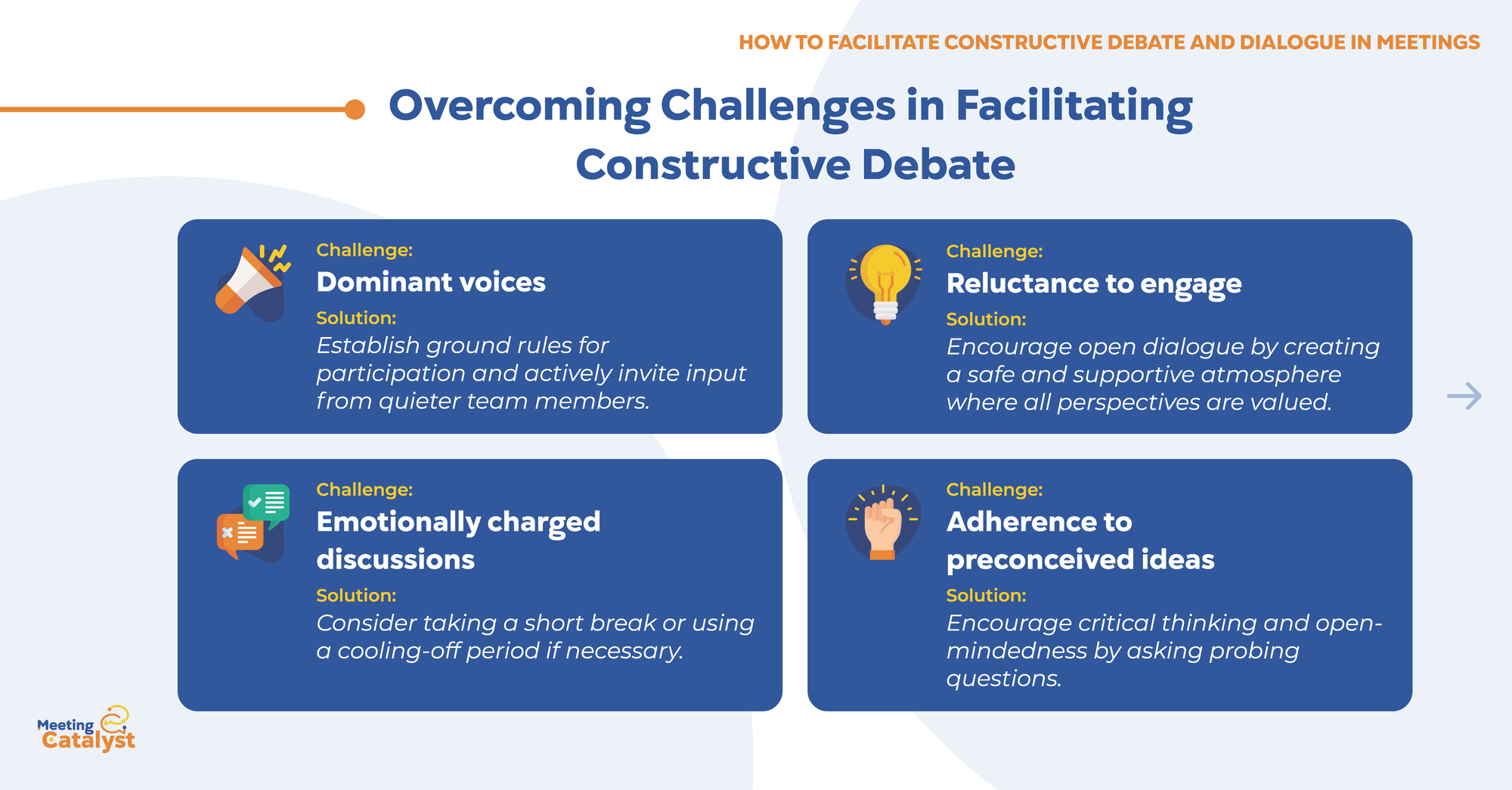
Facilitating constructive debate can sometimes present a variety of challenges, especially in diverse and dynamic team environments. Here are some common obstacles and tips for overcoming them to ensure that the debate remains focused, engaging, and productive:
Dominant voices: In some meetings, a few individuals may dominate the conversation, leaving others feeling unheard or disengaged. To address this, establish ground rules for participation and actively invite input from quieter team members.
Reluctance to engage: Some team members may be hesitant to share their opinions or question others' ideas. Encourage open dialogue by creating a safe and supportive atmosphere where all perspectives are valued.
Emotionally charged discussions: Debates can sometimes become heated and emotional, which can hinder productive dialogue. As a facilitator, remain calm and neutral, and help participants refocus on the topic at hand. Consider taking a short break or using a cooling-off period if necessary.
Adherence to preconceived ideas: Participants may come to the debate with preconceived notions or biases, making it difficult for them to consider alternative perspectives. Encourage critical thinking and open-mindedness by asking probing questions and prompting participants to explore different viewpoints.
Lack of clarity or focus: Without clear objectives or focus, debates can become unfocused and unproductive. Set the agenda beforehand, and regularly remind participants of the meeting's goals and desired outcomes.
Groupthink: In some situations, team members may be hesitant to express dissenting opinions for fear of disrupting group harmony. Foster an environment where diverse perspectives are welcomed and valued, and remind participants of the importance of constructive debate in achieving better decision-making.
Time constraints: Balancing time constraints with the need for thorough debate can be challenging. Establish time limits for each topic, and consider using a timer to ensure that discussions stay on track.
By proactively addressing these challenges, facilitators can create an environment that fosters constructive debate and dialogue, leading to more effective decision-making and problem-solving in meetings.
Conclusion
Facilitating constructive debate and dialogue in meetings is essential for driving innovation, effective decision-making, and fostering a collaborative work environment. By distinguishing between constructive debate and unproductive conflict, organizations can harness the power of diverse perspectives and promote a culture of open communication.
To ensure successful debate and dialogue in meetings, follow these key steps:
- Establish ground rules to create a safe and respectful environment
- Employ techniques for facilitating constructive debate, such as using powerful questions and encouraging active listening
- Manage emotions and conflict during discussions, ensuring that everyone remains focused on the goals
- Encourage participation from all team members, valuing their unique insights and ideas
- Understand the crucial role of the meeting facilitator in guiding the conversation and maintaining a productive atmosphere
Don't forget to adapt these strategies for remote and hybrid meetings, leveraging technology and adjusting communication methods as necessary. By overcoming the challenges of facilitating constructive debate, organizations can drive meaningful conversations, enhance collaboration, and ultimately achieve better outcomes. Learn from the examples set by successful companies, such as Pixar, Amazon, and IDEO, to create a culture where constructive debate and dialogue are valued and nurtured.